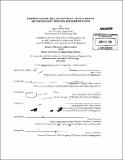Product-level Bill of Material Development Methodology : process implementation
Author(s)
Black, James William
DownloadFull printable version (7.893Mb)
Alternative title
Product-level BOM DM : process implementation
Other Contributors
Leaders for Global Operations Program.
Advisor
Christopher L. Magee and Sara L. Beckman.
Terms of use
Metadata
Show full item recordAbstract
Cisco Systems maintains its leading position in the IP network equipment market through continual innovation and release of new products. In order to manage these new product introductions, the Product Operations group enables the development engine by standardizing and refining operations processes. The Bill of Materials Development Methodology (BOM DM) is a new process created to reduce BOM structuring errors and lead to an improved fulfillment experience for Cisco customers. In keeping with the Six Sigma philosophy, the BOM DM implementation team used the Define-Measure-Analyze-Implement-Control (DMAIC) approach to manage this process but struggled to find the supporting data to appropriately measure critical process parameters or quantify the impact of the solution. After re-evaluation, the approach was modified to maintain the Six Sigma mindset but abandon much of the rigor of DMAIC such that the implementation could be completed within the required timeframe and available resources. This required a new process improvement strategy that would educate the New Product Introduction (NPI) teams on the downstream consequences of their actions so that they would buy in to the need for a standardized best practice. The BOM DM was incorporated into the product development standards and each functional group was given the option to adopt. Six months later the project was reviewed to understand its effect on the company. This thesis serves as a case study of the issues faced on many DMAIC implementations in the real world that experience less than perfect execution. Though sacrificing the confidence that is supported by statistically significant measurement and analysis, the revised approach utilized for the BOM DM implementation leveraged two of Cisco's prized endowments: speed and a creative entrepreneurial spirit. The goal of this thesis is to uncover the tradeoffs of such a compromise and empower managers to decide how best to engage in future process improvements.
Description
Thesis (M.B.A.)--Massachusetts Institute of Technology, Sloan School of Management; and, (S.M.)--Massachusetts Institute of Technology, Engineering Systems Division; in conjunction with the Leaders for Global Operations Program at MIT, 2010. Cataloged from PDF version of thesis. Includes bibliographical references (p. 49).
Date issued
2010Department
Leaders for Global Operations Program at MIT; Massachusetts Institute of Technology. Engineering Systems Division; Sloan School of ManagementPublisher
Massachusetts Institute of Technology
Keywords
Sloan School of Management., Engineering Systems Division., Leaders for Global Operations Program.